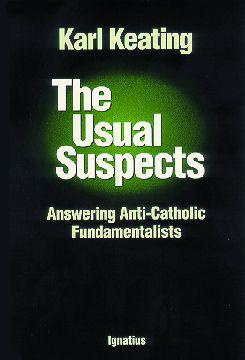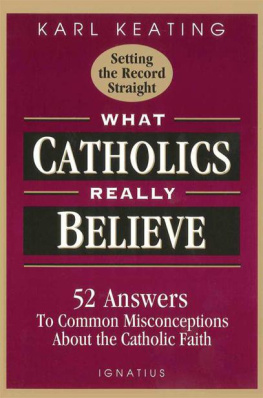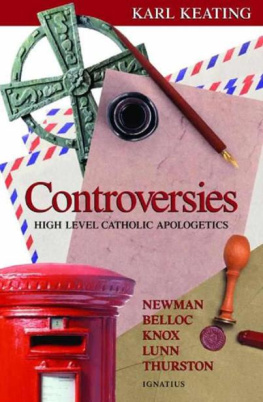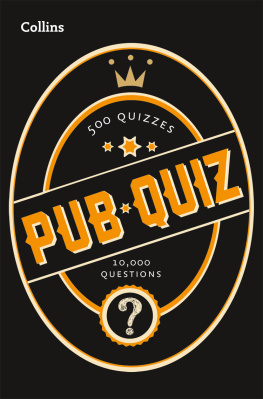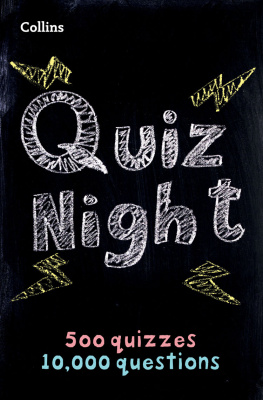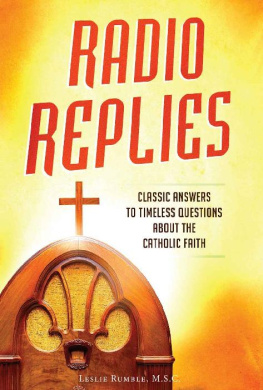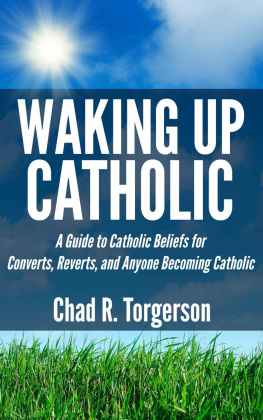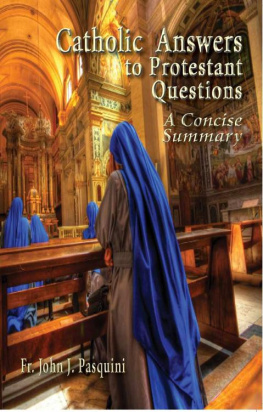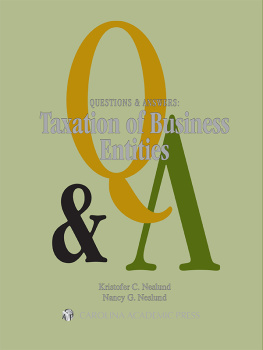THE ULTIMATE CATHOLIC QUIZ
Karl Keating
THE ULTIMATE
CATHOLIC QUIZ
100 Questions Most Catholics Cant Answer
IGNATIUS PRESS SAN FRANCISCO
Except where otherwise noted, Scripture citations are from the Second Catholic Edition of the Revised Standard Version of the Bible 1965, 1966, and 2006 by the Division of Christian Education of the National Council of the Churches of Christ in the United States of America. All rights reserved.
Excerpts from the English translation of the Catechism of the Catholic Church , Second Edition, 1994, 1997, 2000 by Libreria Editrice VaticanaUnited States Conference of Catholic Bishops, Washington, D.C. All rights reserved.
Cover design by Devin Schadt, Saint Louis Creative
2016 by Karl Keating
All rights reserved
Published in 2016 by Ignatius Press, San Francisco
ISBN 978-1-62164-024-0 (PB)
ISBN 978-1-68149-697-9 (EB)
Library of Congress Control Number 2015930776
Printed in the United States of America
For Teruko
Contents
WELCOME!
How well do you know Catholic teachings, practices, and history? Youre about to find out.
In the following pages, I offer for your amusement one hundred questions. Each is followed by five possible answers. Only one of the answers is completely correct. Its your task to find it. It wont be as easy as you might imagine. You will have difficulty in winnowing the answers. Some questions will stump you completely, and youll be reduced to making a random guess. As a concession to those who are easily discouraged, for a few questions I have proposed one or even two glaringly wrong answers. You should be able to spot them immediately. (If you cant, go ahead and feel discouraged.)
There are no trick questions, but there are questions that will trip you up if you fail to read carefully. Words are used precisely and not necessarily in the colloquial sense. An answer is counted as wrong if any part of itsuch as a date or a nameis wrong. Your goal is not to find the answer that is least wrong but the one answer that is wholly right, which may be none of the above.
This quiz does not pretend to be comprehensive. It has only one hundred questions, after all, so most matters of Catholic belief and practice arent mentioned. Still, the questions cover multiple areasdoctrines, morals, customs, history, personalitiesand should provide your mind with a good workout. You likely will find areas of strength and weakness in your knowledge. You might answer all the doctrine questions correctly, but none of the history questions. Or the other way around. None of us is omnicompetent.
I tested some of these questions with groups of intelligent, well-educated Catholics. It may console you to know that never did anyone in those groups find all of the correct answers, and most people found only about half. With that in mind, I suggest that you not reveal to anyone that youre taking this quiz until you learn whether your score merits cheers or jeers.
As you take the quiz, record your answers on a sheet of paper. A scoring scale is provided at the back of the book.
1
The Ark of the Covenant
a. was built by Noah.
b. housed the tablets of the law.
c. was burned piece by piece by Caiaphas.
d. probably never existed; it was made up to instruct the Israelites about Yahwehs mercy.
e. none of the above
a. The Ark of the Covenant wasnt a boat. You will find the account of the Flood, and thus Noahs ark (a very large boat), in Genesis 6-9.
b. Yes. It was more like a safe-deposit box, made of gold-plated wood and measuring two and a half cubits in length and one and a half cubits in width and height. (A cubit is the length from the elbow to the tip of the outstretched middle finger, about eighteen inches.)
c. It was lost centuries before Caiaphas was born. The Babylonians destroyed Jerusalem and Solomons Temple in 597 B.C., and there is no record of the Arks location after that. According to the ancient Jewish historian Josephus, Caiaphas was appointed high priest in A.D. 18.
d. If some adventurous biblical scholar has suggested this, Ive missed the newsand, if he has suggested it, hes wrong.
e. The right answer is b .
2
The patron of air travelers is
a. Saint Frances of Rome.
b. Sister Bertrille, the flying nun.
c. Saint Joseph of Cupertino.
d. Saint Bona of Pisa.
e. none of the above.
a. In 1925 Pope Pius XI named Frances of Rome the patron saint of automobile drivers. His choice derived from the legend that when Frances walked along roads at night, an angel lighted her way with a lantern so that she would not stumble.
b. Sister Bertrille was the name of the main character in the television show The Flying Nun , which ran from 1967 to 1970. She flew when a breeze caught her large, stiff cornette and lifted her off the ground.
c. Joseph of Cupertino (16031663) was a Franciscan friar and mystic known to levitate when in deep prayer, an accomplishment sufficiently impressive for him to be named patron of air travelers, aviators, and astronauts.
d. Bona of Pisa (11561207) almost qualifies. She is the patron saint of travelers in general and specifically of guides, pilgrims, and flight attendantsbut not of air travelers as such.
e. Answer c is correct.
3
Who committed the first sin, not counting the fallen angels?
a. Cain, when he murdered his brother Abel
b. Adam, from whom we inherit original sin
c. Eve, from whom we inherit original sin
d. Adam and Eve together, from whom we inherit original sin
e. none of the above
a. No, since Adam and Eve had sinned even before Cain and Abel were born.
b. No, because Eve sinned before Adam when she ate the forbidden fruit. His sin came immediately thereafter. See Genesis 3:6.
c. Although Eve sinned first and induced Adam to sin, we do not inherit original sin from her but from him, because he was the head of the human race.
d. No, since we dont inherit original sin from Eve.
e. Each of the above answers is incorrect, making this one the right answer.
4
A priests power to confect the Eucharist
a. comes through the people present at Mass; thus, a congregation is needed for a Mass to be valid.
b. is less than a bishops power, but greater than a deacons power, to confect the Eucharist.
c. is given to him through the laying on of hands by his ordaining bishop.
d. was not taught by Vatican II, which recognized that the Eucharist is not confected but is made present spiritually.
e. none of the above
a. How can this be, since a private Mass by a priest is not only valid but encouraged? A priest doesnt need a congregation to celebrate a valid Mass; he doesnt even need an altar server.
b. When it comes to the Eucharist, bishops and priests have exactly the same consecrating power. A deacon has none.
c. This is correct.
d. Vatican II said no such thing. If it had, it would have contradicted infallible teachingan impossibility.
e. The correct answer is c .
5
What is circumincession?
a. the ancient Jewish initiatory rite for male children
b. the indwelling of each Person of the Trinity in the others
c. the manner in which the New World was divided up between Spain and Portugal
d. a manner of procession used by concelebrating priests
e. none of the above
a. No, youre thinking of circumcision.
b. Yes, this is right. Also known by the Greek term perichoresis, circumincession can be spelled as circuminsession . The late Father John Hardon, S.J., defined circumincession this way: The mutual immanence of the three distinct persons of the Holy Trinity. The Father is entirely in the Son, likewise in the Holy Spirit; and so is the Son in the Father and the Holy Spirit; and the Holy Spirit in the Father and the Son ( Modern Catholic Dictionary , Doubleday, 1980, pp. 106-7).
Next page

